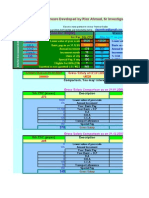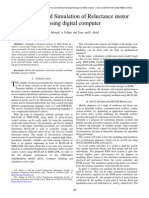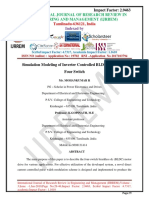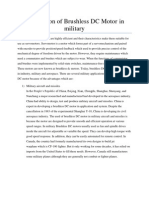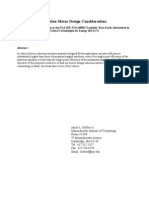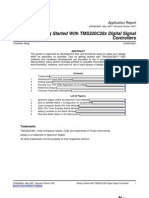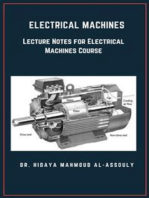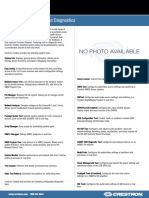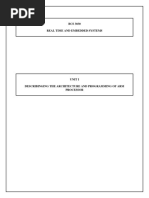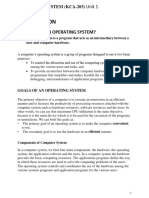0 ratings0% found this document useful (0 votes)
403 viewsDSPACE DS1103 Control Workstation Tutorial and DCMotor Speed Control
This document outlines a project to develop a tutorial for using a dSPACE DS1103 control workstation by implementing a DC motor speed control system. The goals are to determine any additional setup needed for the workstation, write a tutorial paying attention to the DS1103 board using motor speed control as an example, design and implement a DC motor speed controller on the workstation using Simulink blocks and interface libraries, and decrease the learning curve for future users. The controller will control motor speed based on encoder and desired input signals passed through the workstation and connector panel.
Uploaded by
electron1999Copyright
© © All Rights Reserved
Available Formats
Download as PDF, TXT or read online on Scribd
0 ratings0% found this document useful (0 votes)
403 viewsDSPACE DS1103 Control Workstation Tutorial and DCMotor Speed Control
This document outlines a project to develop a tutorial for using a dSPACE DS1103 control workstation by implementing a DC motor speed control system. The goals are to determine any additional setup needed for the workstation, write a tutorial paying attention to the DS1103 board using motor speed control as an example, design and implement a DC motor speed controller on the workstation using Simulink blocks and interface libraries, and decrease the learning curve for future users. The controller will control motor speed based on encoder and desired input signals passed through the workstation and connector panel.
Uploaded by
electron1999Copyright
© © All Rights Reserved
Available Formats
Download as PDF, TXT or read online on Scribd
You are on page 1/ 5
dSPACE DS1103 Control Workstation Tutorial and DC
Motor Speed Control
Functional Description and Complete System Block Diagram
By
Annemarie Thomas
Advisor: Dr. Winfred Anakwa
November 11, 2008
Thomas 1
Introduction
The dSPACE DS1102 was first used at Bradley University in the year 2000 when a users
manual and a workstation based on this board were developed. Since then, a newer dSPACE
DS1103 board has been developed. With grant from the Bradley College of Engineering of
$2,000 and additional funds of $12,200 provided by Dr. Larry Kendrick at the Caterpillar
Technical Center, a dSPACE DS1103 board and additional parts needed have been purchased to
set up a DS1103 workstation. Initial setup has been completed by Mr. Chris Mattus. Now,
someone must learn how to use it. The object of the dSPACE DS1103 Control Workstation
Tutorial and DC Motor Speed Control project is to develop a tutorial for use of the new dSPACE
DS1103 Workstation by implementing a DC motor speed control system. The tutorial will
minimize the time required for future students to become proficient in using the workstation,
therefore increasing the time they can spend designing and implementing more complex control
systems.
Project
The goals for the dSPACE DS1103 Control Workstation Tutorial and DC Motor Speed Control
project are the following:
Determine and implement any additional setup that may be required for the dSPACE
DS1103 control workstation.
Write a tutorial for use of the workstation, paying particular attention to details
related to the DS1103 board using a DC motor speed controller as the example
application.
Design a controller to control the speed of a DC motor.
Implement the designed DC motor speed controller on the dSPACE DS1103 system
using the Simulink and the dSPACE blocksets, the Matlab-to-DSP interface libraries,
Real-Time Interface to Simulink, and Real-Time Workshop.
The ultimate goal of this project is to decrease the learning curve for future students who use the
workstation for more complex projects. Past projects completed by Bradley University students
using the dSPACE DS1102 board included OFDM transmission and magnetic suspension
projects. The dSPACE DS1103 Control workstation could be used for similar projects and is
well adapted for use in automobile [1], airplane, and many other control applications.
Description
The design portion of this project involves designing and implementing a motor speed controller
using the dDSPACE DS1103 board. The controller will be simulated and designed using the
Simulink and the dSPACE blocksets, the Matlab-to-DSP interface libraries, Real-Time Interface
to Simulink, and Real-Time Workshop on a PC. The controller will then be downloaded onto
the Texas Instruments TM320F240 DSP [1] located on the DS1103 board. Inputs to the
DS1103 will include the desired motor speed and the output of an optical encoder connected to
the motor. Outputs from the DS1103 will include the input to the motor, possibly a PWM signal,
and a display of the actual motor speed. Inputs to and outputs from the DS1103 will pass
Thomas 2
through the CLP1103 [2] connector panel for the DS1103 board. The motors speed should
remain steady for any reasonable amount of load torque applied to it by a braking system. A
general block diagram for the system is shown in figure 1 below.
Input Desired
Speed (From
ControlDesk or
voltage sent
through CLP1103)
DS1103
Motor System
ControlDesk
Load Applied to
Motor Shaft
By Brake
Optical Encoder
System
CLP1103
Connector
Panel
Figure 1: Motor Speed Control System Block Diagram
Testing of the initial controller design can be done by modeling the Motor System, Optical
Encoder System, and CLP Connector Panel, shown in figure 1 above, in Simulink. A simple
motor model is shown in figure 2 below. From this model, a closed loop control block diagram
can be generated with a transfer function for the input voltage into the motor, Va, in relation to
the output, w, in radians per second, which can then be easily be converted to other formats such
as RPM (revolutions per minute). A simple transfer function that can be used to model the motor
in the frequency domain, in terms of s, is:
w / Va = Kt / [ ( Ra + s * La ) * ( B + s * J ) + Kt * Kv ] (1)
where Ra and La are the electrical resistance and inductance of the motor, J and B are the
mechanical inertia and damping/friction of the motor, and Kt and Kv are the torque constant and
back emf constant of the motor. These values will be found in the motors datasheet(s) and
verified experimentally.
w
B
Ra
La
Va J
Figure 2: Simple Motor Model Schematic
Controller
The controller will be designed using the various development and simulation tools found on the
PC for the workstation. It will then be downloaded to the DSP in the DS1103 shown in figure
1 on the previous page using the ControlDesk software package also on the PC. The
complexity and other specifications of the motor speed controller design have not yet been
determined. A simple proportional (P) controller design would probably be implemented first to
Thomas 3
gain experience and knowledge with the overall system, and then one or several more complex
controllers would probably be designed and implemented. The output from the DS1103 is
currently expected to be a PWM signal.
ControlDesk
ControlDesk in figure 1 on the previous page serves multiple uses. It provides the interface for
downloading controller models designed in Simulink onto the DSP. The Instrument Panel
feature of ControlDesk can be used as an input device for the system and as a data output device.
It may be possible to control the input value for the Simulink model using the Instrument panel,
but more research in this area is needed to be certain of this. The output from the Optical
Encoder System can definitely be sent through the CLP1103 and DS1103 to the computer and
various measurements can be displayed on the PC screen. [3] Initially, measurement of the
system response (the actual motor speed) will be measured by connecting the output of the
Optical Encoder to an oscilloscope.
CLP1103
The CLP1103 shown in figure 1 on the previous page serves as an interface between the
DS1103 and the external hardware portion (Motor System, Optical Encoder System, and
possibly the Desired Input) of the overall system. The CLP1103 contains connector for twenty
(20) Analog-to-Digital inputs, eight (8) Digital-to-Analog outputs, several other connectors that
can be used for Digital I/O, Slave/DSP I/O, Incremental Encoder Interfaces, CAN interface, and
Serial Interfaces. [2]
Motor System
The Motor System identified in the block diagram in figure 1 on the previous page will include
the motor and additional analog components. The analog components will include either a
transistor or an H-bridge to further process the output from the DS1103 board (passed through
the CLP1103 Connector Panel) before it enters the motor.
Thomas 4
Optical Encoder System
The Optical Encoder System shown in figure 1 on page 2 may be just an optical encoder
connected to the motor and necessary pull-up resistors and power/ground connections, but
additional analog components might be added to convert the optical encoder output signal into a
form that can be more easily handled by the DSP.
Speed Input
A means of inputting the speed at which the motor is desired to operate is needed. This is shown
as the Input Desired Speed Block in figure 1 on page 2. The speed could be hard coded into
the controller or an external signal could be used to vary the desired operating speed. Initial
design and implementation will most likely use a hard-coded value, but eventually it should be
possible to control the desired speed by using a DC voltage supply or some other type of input.
Current research is inconclusive, but it might also be possible to set desired input using the
Instrument Panel Feature of ControlDesk, see ControlDesk section on the previous page. This
would be the preferred option if it is possible.
Conclusion
In order to successfully complete the dSPACE DS1103 Control Workstation Tutorial and DC
Motor Speed Control project, the required software packages and their interaction with the
dSPACE DS1103 board must be investigated and well-understood. Currently, not much
information can be found related to the DS1103 other than what is contained in the manuals
[3,4]. This project will hopefully be a step in solving that problem and make it easier for future
Bradley University students and perhaps others as well to use these boards.
References
[1] DS1103 PPC Controller Board, Germany: dSPACE, July 2008.
[2] Connector and LED Panels, Catalog 2008, Germany: dSPACE:2008, p. 302.
[3] ControlDesk Experiment Guide For ControlDesk 3.2, Germany: dSPACE GmbH, 2008,
Release 6.1.
[4] dSPACE System First Work Steps For DS1103, DS1104, DS1005, DS1006, and Micro Auto
Box, Germany: dSPACE GmbH, 2007, Release 6.0.
You might also like
- 6th Central Pay Commission Salary Calculator100% (436)6th Central Pay Commission Salary Calculator15 pages
- Maximising E Machine Efficiency With Hairpin Windings White PaperNo ratings yetMaximising E Machine Efficiency With Hairpin Windings White Paper7 pages
- Modeling and Simulation of Reluctance Motor Using Digital ComputerNo ratings yetModeling and Simulation of Reluctance Motor Using Digital Computer5 pages
- Simulation Modeling of Inverter Controlled BLDC Drive Using Four SwitchNo ratings yetSimulation Modeling of Inverter Controlled BLDC Drive Using Four Switch18 pages
- Design of 3-Phase BLDC Motor For Electric Vehicle Application by Using Finite Element SimulationNo ratings yetDesign of 3-Phase BLDC Motor For Electric Vehicle Application by Using Finite Element Simulation6 pages
- Implementation OF Four Quadrant Operation OF BLDC Motor Using MPCNo ratings yetImplementation OF Four Quadrant Operation OF BLDC Motor Using MPC65 pages
- Efficiency Evaluation of Induction Motor Using Synthetic LoadNo ratings yetEfficiency Evaluation of Induction Motor Using Synthetic Load85 pages
- Speed Control of BLDC Motor For Electric PDFNo ratings yetSpeed Control of BLDC Motor For Electric PDF6 pages
- Application of Brushless DC Motor in Military100% (1)Application of Brushless DC Motor in Military10 pages
- BLDC Motor FEA Simulation Using Ansys-PostNo ratings yetBLDC Motor FEA Simulation Using Ansys-Post3 pages
- Field Oriented Control of Ac Motor - ReportNo ratings yetField Oriented Control of Ac Motor - Report9 pages
- Design and Analysis of Brushless DC Motors For Ceiling Fan ApplicationNo ratings yetDesign and Analysis of Brushless DC Motors For Ceiling Fan Application6 pages
- Torque of ThreePhase Induction Motor ExplainedNo ratings yetTorque of ThreePhase Induction Motor Explained2 pages
- Brushless DC Motor: Apurva Sanjay Mahajan, Yugandhara Sanjay Mahajan, Sneha Vijay WadjeNo ratings yetBrushless DC Motor: Apurva Sanjay Mahajan, Yugandhara Sanjay Mahajan, Sneha Vijay Wadje5 pages
- Accelarating Motor Design & DevelopementNo ratings yetAccelarating Motor Design & Developement19 pages
- 2012 Practical Strategies For Improved Cooling of Electrical Motors and Generators Dave Staton INDUCTICA TECHNICAL CONFERENCE PDFNo ratings yet2012 Practical Strategies For Improved Cooling of Electrical Motors and Generators Dave Staton INDUCTICA TECHNICAL CONFERENCE PDF8 pages
- MV AC Drive Topology Analysis 1143643595No ratings yetMV AC Drive Topology Analysis 114364359549 pages
- 13 - Ansys Maxwell 3D vs. FEMAG 2D.LaubeNo ratings yet13 - Ansys Maxwell 3D vs. FEMAG 2D.Laube18 pages
- SimulationofBLDCMotorinANSYSMaxwell PDFNo ratings yetSimulationofBLDCMotorinANSYSMaxwell PDF109 pages
- Speed Control of Universal Motor Using Sniversal Bridge100% (1)Speed Control of Universal Motor Using Sniversal Bridge5 pages
- Speed Control of PMSM Using HALL Signal Effect With Six Pulse Inverter in MATLAB/SIMLINKNo ratings yetSpeed Control of PMSM Using HALL Signal Effect With Six Pulse Inverter in MATLAB/SIMLINK8 pages
- Permanent Magnet Synchronous Motor Parameter Identification Using Particle Swarm OptimizationNo ratings yetPermanent Magnet Synchronous Motor Parameter Identification Using Particle Swarm Optimization8 pages
- GettingStartedWithTMS320C28XDigitalSignalControllers Spraam0a100% (2)GettingStartedWithTMS320C28XDigitalSignalControllers Spraam0a17 pages
- Um2788 Getting Started With The Motor Control Sixstep Firmware Example For Stevalptool2v1 StmicroelectronicsNo ratings yetUm2788 Getting Started With The Motor Control Sixstep Firmware Example For Stevalptool2v1 Stmicroelectronics29 pages
- Vector Control of Induction Motor Without Shaft EncoderNo ratings yetVector Control of Induction Motor Without Shaft Encoder8 pages
- Simulation of Some Power System, Control System and Power Electronics Case Studies Using Matlab and PowerWorld SimulatorFrom EverandSimulation of Some Power System, Control System and Power Electronics Case Studies Using Matlab and PowerWorld SimulatorNo ratings yet
- Electrical Machines: Lecture Notes for Electrical Machines CourseFrom EverandElectrical Machines: Lecture Notes for Electrical Machines CourseNo ratings yet
- Integration of Demand Response into the Electricity Chain: Challenges, Opportunities, and Smart Grid SolutionsFrom EverandIntegration of Demand Response into the Electricity Chain: Challenges, Opportunities, and Smart Grid SolutionsNo ratings yet
- Young-Man Kim - Digital Tachometer With Dragon Board-12No ratings yetYoung-Man Kim - Digital Tachometer With Dragon Board-129 pages
- DS 1104 Based State Observer Design For Position Control of DC Servo MotorNo ratings yetDS 1104 Based State Observer Design For Position Control of DC Servo Motor9 pages
- Garage Door Opener Owner's Manual: For Residential Use OnlyNo ratings yetGarage Door Opener Owner's Manual: For Residential Use Only28 pages
- Design and Develop An IGBT Inverter For AC Motor Drive Applications100% (1)Design and Develop An IGBT Inverter For AC Motor Drive Applications40 pages
- Rodamientos Bosh-Rexroth Buscando Parte 1621-714-10 Aad7n Original de WeekeNo ratings yetRodamientos Bosh-Rexroth Buscando Parte 1621-714-10 Aad7n Original de Weeke264 pages
- A Conceptual Study On Fundamentals and Characteristics of Embedded SystemsNo ratings yetA Conceptual Study On Fundamentals and Characteristics of Embedded Systems3 pages
- Onboard Data Handling: Gert Caspersen Terma A/SNo ratings yetOnboard Data Handling: Gert Caspersen Terma A/S31 pages
- Google VCEup - Com - Professional-Data-Engineer 2022-July-05 173qNo ratings yetGoogle VCEup - Com - Professional-Data-Engineer 2022-July-05 173q64 pages
- Characteristics of Embedded System: Basic Software Techniques For Embedded ApplicationsNo ratings yetCharacteristics of Embedded System: Basic Software Techniques For Embedded Applications31 pages
- Metro Train Prototype USING 8051: Submitted By: Vishwanath Sarkar Mayank Gupta 3 Yr., E&C, Manit-BhopalNo ratings yetMetro Train Prototype USING 8051: Submitted By: Vishwanath Sarkar Mayank Gupta 3 Yr., E&C, Manit-Bhopal67 pages
- Digital Twin For Real-Time Li-Ion Battery State of Health Estimation With Partially Discharged Cycling DataNo ratings yetDigital Twin For Real-Time Li-Ion Battery State of Health Estimation With Partially Discharged Cycling Data11 pages
- Xinhua Digital Electro-Hydraulic Control System DEH-V For Steam Turbines100% (1)Xinhua Digital Electro-Hydraulic Control System DEH-V For Steam Turbines36 pages
- 1.0 What Is Operating System?: Four Components of Computer SystemNo ratings yet1.0 What Is Operating System?: Four Components of Computer System8 pages
- Unit 3 Introduction To Operating System ConceptsNo ratings yetUnit 3 Introduction To Operating System Concepts19 pages
- Machine Learning and Predictive Analytics Guidebook For Water Engineers Ge DigitalNo ratings yetMachine Learning and Predictive Analytics Guidebook For Water Engineers Ge Digital10 pages
- Embedded Systems Based Questions and AnswersNo ratings yetEmbedded Systems Based Questions and Answers2 pages
- Real-Time Vehicle Detection and Tracking Using Raspberry PINo ratings yetReal-Time Vehicle Detection and Tracking Using Raspberry PI9 pages
- Extending The Reach of Real-Time Analytics:: Hardware and Software, Engineered To Work TogetherNo ratings yetExtending The Reach of Real-Time Analytics:: Hardware and Software, Engineered To Work Together8 pages
- Profile: Adaptive Control of Resistance WeldingNo ratings yetProfile: Adaptive Control of Resistance Welding4 pages
- Maximising E Machine Efficiency With Hairpin Windings White PaperMaximising E Machine Efficiency With Hairpin Windings White Paper
- Computer Aided Design of Electrical MachinesFrom EverandComputer Aided Design of Electrical Machines
- Modeling and Simulation of Reluctance Motor Using Digital ComputerModeling and Simulation of Reluctance Motor Using Digital Computer
- Simulation Modeling of Inverter Controlled BLDC Drive Using Four SwitchSimulation Modeling of Inverter Controlled BLDC Drive Using Four Switch
- Design of 3-Phase BLDC Motor For Electric Vehicle Application by Using Finite Element SimulationDesign of 3-Phase BLDC Motor For Electric Vehicle Application by Using Finite Element Simulation
- Implementation OF Four Quadrant Operation OF BLDC Motor Using MPCImplementation OF Four Quadrant Operation OF BLDC Motor Using MPC
- Efficiency Evaluation of Induction Motor Using Synthetic LoadEfficiency Evaluation of Induction Motor Using Synthetic Load
- Design and Analysis of Brushless DC Motors For Ceiling Fan ApplicationDesign and Analysis of Brushless DC Motors For Ceiling Fan Application
- Brushless DC Motor: Apurva Sanjay Mahajan, Yugandhara Sanjay Mahajan, Sneha Vijay WadjeBrushless DC Motor: Apurva Sanjay Mahajan, Yugandhara Sanjay Mahajan, Sneha Vijay Wadje
- 2012 Practical Strategies For Improved Cooling of Electrical Motors and Generators Dave Staton INDUCTICA TECHNICAL CONFERENCE PDF2012 Practical Strategies For Improved Cooling of Electrical Motors and Generators Dave Staton INDUCTICA TECHNICAL CONFERENCE PDF
- Speed Control of Universal Motor Using Sniversal BridgeSpeed Control of Universal Motor Using Sniversal Bridge
- Speed Control of PMSM Using HALL Signal Effect With Six Pulse Inverter in MATLAB/SIMLINKSpeed Control of PMSM Using HALL Signal Effect With Six Pulse Inverter in MATLAB/SIMLINK
- Permanent Magnet Synchronous Motor Parameter Identification Using Particle Swarm OptimizationPermanent Magnet Synchronous Motor Parameter Identification Using Particle Swarm Optimization
- GettingStartedWithTMS320C28XDigitalSignalControllers Spraam0aGettingStartedWithTMS320C28XDigitalSignalControllers Spraam0a
- Um2788 Getting Started With The Motor Control Sixstep Firmware Example For Stevalptool2v1 StmicroelectronicsUm2788 Getting Started With The Motor Control Sixstep Firmware Example For Stevalptool2v1 Stmicroelectronics
- Vector Control of Induction Motor Without Shaft EncoderVector Control of Induction Motor Without Shaft Encoder
- Simulation of Some Power System, Control System and Power Electronics Case Studies Using Matlab and PowerWorld SimulatorFrom EverandSimulation of Some Power System, Control System and Power Electronics Case Studies Using Matlab and PowerWorld Simulator
- Electrical Machines: Lecture Notes for Electrical Machines CourseFrom EverandElectrical Machines: Lecture Notes for Electrical Machines Course
- Integration of Demand Response into the Electricity Chain: Challenges, Opportunities, and Smart Grid SolutionsFrom EverandIntegration of Demand Response into the Electricity Chain: Challenges, Opportunities, and Smart Grid Solutions
- Young-Man Kim - Digital Tachometer With Dragon Board-12Young-Man Kim - Digital Tachometer With Dragon Board-12
- DS 1104 Based State Observer Design For Position Control of DC Servo MotorDS 1104 Based State Observer Design For Position Control of DC Servo Motor
- Garage Door Opener Owner's Manual: For Residential Use OnlyGarage Door Opener Owner's Manual: For Residential Use Only
- Design and Develop An IGBT Inverter For AC Motor Drive ApplicationsDesign and Develop An IGBT Inverter For AC Motor Drive Applications
- Rodamientos Bosh-Rexroth Buscando Parte 1621-714-10 Aad7n Original de WeekeRodamientos Bosh-Rexroth Buscando Parte 1621-714-10 Aad7n Original de Weeke
- A Conceptual Study On Fundamentals and Characteristics of Embedded SystemsA Conceptual Study On Fundamentals and Characteristics of Embedded Systems
- Google VCEup - Com - Professional-Data-Engineer 2022-July-05 173qGoogle VCEup - Com - Professional-Data-Engineer 2022-July-05 173q
- Characteristics of Embedded System: Basic Software Techniques For Embedded ApplicationsCharacteristics of Embedded System: Basic Software Techniques For Embedded Applications
- Metro Train Prototype USING 8051: Submitted By: Vishwanath Sarkar Mayank Gupta 3 Yr., E&C, Manit-BhopalMetro Train Prototype USING 8051: Submitted By: Vishwanath Sarkar Mayank Gupta 3 Yr., E&C, Manit-Bhopal
- Digital Twin For Real-Time Li-Ion Battery State of Health Estimation With Partially Discharged Cycling DataDigital Twin For Real-Time Li-Ion Battery State of Health Estimation With Partially Discharged Cycling Data
- Xinhua Digital Electro-Hydraulic Control System DEH-V For Steam TurbinesXinhua Digital Electro-Hydraulic Control System DEH-V For Steam Turbines
- 1.0 What Is Operating System?: Four Components of Computer System1.0 What Is Operating System?: Four Components of Computer System
- Machine Learning and Predictive Analytics Guidebook For Water Engineers Ge DigitalMachine Learning and Predictive Analytics Guidebook For Water Engineers Ge Digital
- Real-Time Vehicle Detection and Tracking Using Raspberry PIReal-Time Vehicle Detection and Tracking Using Raspberry PI
- Extending The Reach of Real-Time Analytics:: Hardware and Software, Engineered To Work TogetherExtending The Reach of Real-Time Analytics:: Hardware and Software, Engineered To Work Together
